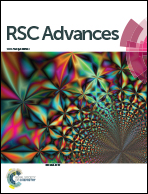Soft approach hydrothermal synthesis of a 3D sulfur/graphene/ multiwalled carbon nanotube cathode for lithium–sulfur batteries
Abstract
Lithium–sulphur (Li–S) batteries with high theoretical energy densities are regarded as promising energy storage devices for electric vehicles and large-scale electricity storage. We report a facile, environment friendly, soft approach and scalable synthesis of a sulfur/graphene/multiwalled carbon nanotube (S/GN/MWCNTs) composite as a cathode for Li–S batteries by a one-pot hydrothermal method. The 2D graphene nanosheets and 1D carbon nanotubes have been chosen as a scaffold because of their conductive carbon skeleton and high specific surface area. In the composite, the carbon nanotubes can not only significantly enhance the conductivity, but also effectively tune the mesoporous structure. The as-prepared S/GN/MWCNTs hybrid electrode delivers an initial discharge capacity of 1135.9 mA h g−1 at 0.2C. Moreover, at a high current rate of 0.8C, it exhibits excellent cyclability and coulombic efficiency, the reversible charge capacity stays at 702.3 mA h g−1 after 100 cycles and the coulombic efficiency is up to 96.3%. The results confirm that the one-pot hydrothermal method is a promising approach for the synthesis of composite for lithium–sulfur batteries.



 Please wait while we load your content...
Please wait while we load your content...